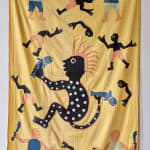 Appliqued hanging
Appliqued hanging
 Appliqued hanging
Appliqued hanging
 Appliqued hanging
Appliqued hanging
Yémadjé family (Kingdom of Dahomey, Republic of Benin)
66 93/100 x 41 17/50 in
Further images
These beautiful appliqué banners are among the most important items of royal court art from the Kingdom of Dahomey, now in the Republic of Benin. Until they transferred their role to the making of tourist arts in the mid 20th century, families of specialist textile workers at the court in Abomey supplied dramatic wall hangings that praised the king and illustrated key aspects of his social identity and achievements.
This applied canvas reveals, in the center of a yellow background, a central figure, that of a supernatural anthropozoomorphic creature holding a fish in its hand and tail. On its black body are scattered white spots, a sign he is suffering from smallpox and thus under the spell of the powerful Fon god Sagbata. Above and below this figure we find battle scenes where the king’s soldiers defeat his Nago-Yoruba enemies, who can be identified by their ethnic scars on their cheeks. Their bodies cut in two, this banner probably refered to a historical denunciation, the textile serving a commemorative function.
The quai Branly museum in Paris holds a very similar banner that entered their collections before 1936 and is also attributed to the famous Yémadjé family (#71.1936.21.13). This family were the principal appliqué workers at the Dahomey court, to whom all royal commissions were confided. Note that the soldiers and the enemies were cut from two patterns.
Provenance
Collected by Emile Jourdan (1898-1970) between 1921-1928
By descent through family, -2021
De Baecque & Associés, Paris, 12 February 2021, lot 90.
Private Collection, Brussels
let's keep in touch
Join our community & never miss out on a DUENDE moment from now on
* denotes required fields
We will process the personal data you have supplied to communicate with you in accordance with our Privacy Policy. You can unsubscribe or change your preferences at any time by clicking the link in our emails.


